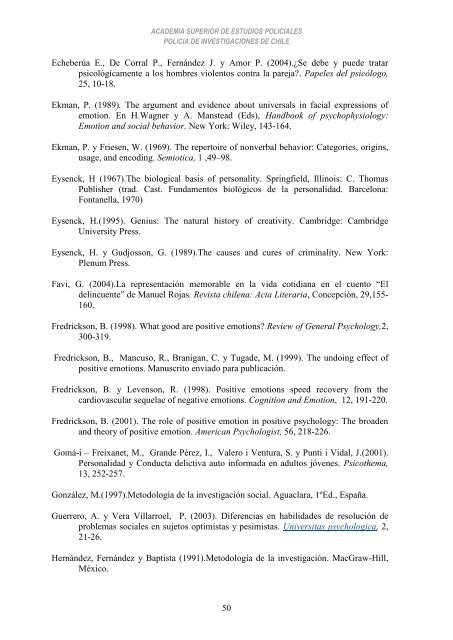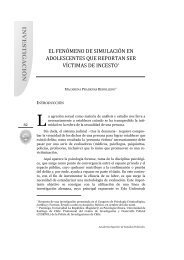Estudio comparativo sobre niveles de impulsividad y la tendencia al ...
Estudio comparativo sobre niveles de impulsividad y la tendencia al ...
Estudio comparativo sobre niveles de impulsividad y la tendencia al ...
You also want an ePaper? Increase the reach of your titles
YUMPU automatically turns print PDFs into web optimized ePapers that Google loves.
ACADEMIA SUPERIOR DE ESTUDIOS POLICIALES<br />
POLICIA DE INVESTIGACIONES DE CHILE<br />
Echeberúa E., De Corr<strong>al</strong> P., Fernán<strong>de</strong>z J. y Amor P. (2004).¿Se <strong>de</strong>be y pue<strong>de</strong> tratar<br />
psicológicamente a los hombres violentos contra <strong>la</strong> pareja?. Papeles <strong>de</strong>l psicólogo,<br />
25, 10-18.<br />
Ekman, P. (1989). The argument and evi<strong>de</strong>nce about univers<strong>al</strong>s in faci<strong>al</strong> expressions of<br />
emotion. En H.Wagner y A. Manstead (Eds), Handbook of psychophysiology:<br />
Emotion and soci<strong>al</strong> behavior. New York: Wiley, 143-164.<br />
Ekman, P. y Friesen, W. (1969). The repertoire of nonverb<strong>al</strong> behavior: Categories, origins,<br />
usage, and encoding. Semiotica, 1 ,49–98.<br />
Eysenck, H (1967).The biologic<strong>al</strong> basis of person<strong>al</strong>ity. Springfield, Illinois: C. Thomas<br />
Publisher (trad. Cast. Fundamentos biológicos <strong>de</strong> <strong>la</strong> person<strong>al</strong>idad. Barcelona:<br />
Fontanel<strong>la</strong>, 1970)<br />
Eysenck, H.(1995). Genius: The natur<strong>al</strong> history of creativity. Cambridge: Cambridge<br />
University Press.<br />
Eysenck, H. y Gudjosson, G. (1989).The causes and cures of crimin<strong>al</strong>ity. New York:<br />
Plenum Press.<br />
Favi, G. (2004).La representación memorable en <strong>la</strong> vida cotidiana en el cuento “El<br />
<strong>de</strong>lincuente” <strong>de</strong> Manuel Rojas. Revista chilena: Acta Literaria, Concepción, 29,155-<br />
160.<br />
Fredrickson, B. (1998). What good are positive emotions? Review of Gener<strong>al</strong> Psychology,2,<br />
300-319.<br />
Fredrickson, B., Mancuso, R., Branigan, C. y Tuga<strong>de</strong>, M. (1999). The undoing effect of<br />
positive emotions. Manuscrito enviado para publicación.<br />
Fredrickson, B. y Levenson, R. (1998). Positive emotions speed recovery from the<br />
cardiovascu<strong>la</strong>r seque<strong>la</strong>e of negative emotions. Cognition and Emotion, 12, 191-220.<br />
Fredrickson, B. (2001). The role of positive emotion in positive psychology: The broa<strong>de</strong>n<br />
and theory of positive emotion. American Psychologist, 56, 218-226.<br />
Gomá-i – Freixanet, M., Gran<strong>de</strong> Pérez, I., V<strong>al</strong>ero i Ventura, S. y Punti i Vid<strong>al</strong>, J.(2001).<br />
Person<strong>al</strong>idad y Conducta <strong>de</strong>lictiva auto informada en adultos jóvenes. Psicothema,<br />
13, 252-257.<br />
González, M.(1997).Metodología <strong>de</strong> <strong>la</strong> investigación soci<strong>al</strong>. Aguac<strong>la</strong>ra, 1ºEd., España.<br />
Guerrero, A. y Vera Vil<strong>la</strong>rroel, P. (2003). Diferencias en habilida<strong>de</strong>s <strong>de</strong> resolución <strong>de</strong><br />
problemas soci<strong>al</strong>es en sujetos optimistas y pesimistas. Universitas psychologica, 2,<br />
21-26.<br />
Hernán<strong>de</strong>z, Fernán<strong>de</strong>z y Baptista (1991).Metodología <strong>de</strong> <strong>la</strong> investigación. MacGraw-Hill,<br />
México.<br />
50



